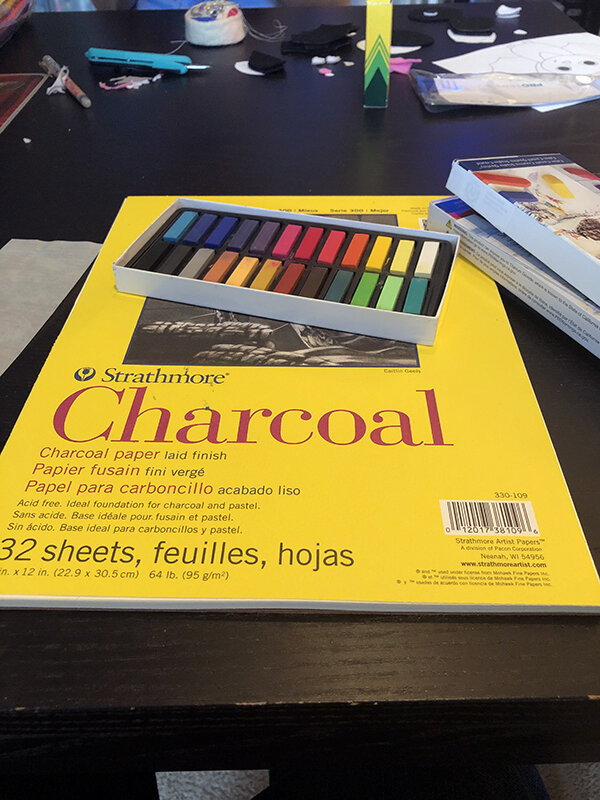I think this may be the first time in my life I’ve ever touched pastels. While I was excited to give them a try, I’ll cop to being a little nervous about working in yet another medium that tends to eschew the use of lines, and to work in solid color. As an undergraduate drawing major, most of the materials with which I’m most familiar are grayscale: Graphite, pen and ink, inkwash, charcoal…we did use conte crayons occasionally, but even those were limited to a 3 color palette. For whatever reason, in my drawing program color was treated like your uncle’s drinking problem at Thanksgiving: We all know it’s a thing, but we’re trying our best not to acknowledge it.
Having never used these before, the first thing I did was head to Michaels to pick up a Faber-Castell box of 24 soft pastels. This is perhaps more colors than were necessary for a beginner, but was the smallest set of “studio quality” materials in stock (the lower quality “student grade” was available in a 12 pack). They rang up at $19.99, but since this was Michaels, expect to pay half that anywhere else. I also went with a 32 sheet, 9x12” Strathmore Charcoal paper pad simply because it said “Ideal foundation for pastel” on the cover. The paper was $15, but again, Michaels. Buying from them is like paying the Canadian rate they used to list beneath the “real price” on books and magazines. If you choose to buy your supplies from Michaels, consider the mark up an “idiot tax.”
Supplies in hand, it was time to go about figuring out how these things work. Soft pastels feel very similar in texture and consistency to vine charcoal. Just kind of making marks willy-nilly, varying pressure, and rubbing the results with various blending instruments worked well for me in that medium, so I replicated the same tests this go round to similar results. I was immediately struck by how malleable the marks were. It’s quite easy to go from soft and delicate lines, to hard, intense areas of color with just a little firmness of hand. A kneaded eraser can pick up a good 80-90% of the pigment in most applications. Blending was silky smooth with a tortillon, a paper towel, a Q-tip, or a finger. Simply laying down 2 colors next to each other and swiping between them with a single pass of an index finger creates a smooth, pleasing gradient.
This ease of blending can work as a double-edged sword. With charcoal, having residue on your finger (or tool) before blending offers no real consequence. In a color medium, being careless about cleaning can quickly lead to cross-contamination and muddied colors, something that plagued my final drawing even though I was aware of the issue at that point.
Also, to a certain degree, working with soft pastels is like trying to draw with Pixie Sticks. The powder just kind of sits on the surface, if a butterfly flaps it’s wings within a hundred feet of you your drawing is liable to blow away. Keep in mind that chalk powder WILL be everywhere when planning a workspace.
The final drawing was just a matter of combining what I’d learned through experimentation and applying it to a larger project. For my subject matter, when in doubt, draw a piece of fruit. There’s not much to say here, as it was a standard process of blocking in a shape with pencil, and then laying in color. Aware that my color knowledge was an obvious shortcoming, I stuck with our Exploring Studio Materials textbook’s advice and limited the number of hues at my disposal. I think I kept it to just the primaries, plus green, and tried to create any other colors I needed through blending.
One thing worth noting that I wish I’d discovered earlier is that chalk pastel seems to work best with a light to dark approach, as opposed to the dark to light method I used. It was late in the process when I discovered that the lighter yellows and white highlights I tried to apply in the final stages just weren’t showing up very well. As mentioned earlier, I did a poor job remembering to clean my finger tips between blending passes, significantly muddying up my colors.
All in all, this was a fun experiment, and chalk pastels are definitely something I’d like to get more familiar with. It strikes me as a lower stakes entry point into painting, something I’m also inexperienced with (a seemingly running theme of these blog entries) and a quick and easy way to begin building a knowledge of color theory. I think I can only improve from here, and I’m excited to try.
Some notes about usage in a classroom context:
-Fixatiff is necessary to bind the final drawing. As always, take that outside or have an adult do it.
-While similar to charcoal in terms of tactile fun, methodology of use and safety of materials, I actually think chalk pastels can skew much younger. They’re appropriate for practically any age group. The final product will appear much more refined if created by a person thinking in terms of volume, light and shadow, but as this is a color medium, even abstract markings can create a vibrant, engaging piece. With charcoal, smearing powder all over a canvas will basically lead to a solid black mess. A pictorial representation of the infinite void. Color pastels are a lot more forgiving, and can be approached by very young children as powdery, easily smudged crayons.
























